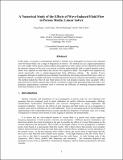A Numerical Study of the Effects of Wave-Induced Fluid Flow in Porous Media: Linear Solver
Author(s)
Zhang, Yang; Song, Limin; Deffenbaugh, Max; Toksoz, M. Nafi
DownloadYang_2009.pdf (308.4Kb)
Other Contributors
Massachusetts Institute of Technology. Earth Resources Laboratory
Metadata
Show full item recordAbstract
In this paper, we present a computational method to simulate wave propagation in porous rocks saturated
with Newtonian fluids over a range of frequencies of interest. The method can use a digital representation
of a rock sample where distinct material phase and properties at each volume cell are identified and model
the dynamic response of the rock to an acoustic excitation mathematically with a coupled equation system:
elastic wave equation in solid matrix and viscous wave equation in fluid. The coupled wave equations are
solved numerically with a rotated-staggered-grid finite difference scheme. We simulate P-wave
propagation through an idealized porous medium of periodically alternating solid and fluid layers where an
analytical solution is available and obtain excellent agreements between numerical and analytical solutions.
The method models the effect of pore fluid motion on the rock dynamic response more accurately with a
linearized Navier-Stokes equation than with the viscoelastic model of the generalized Maxwell body, a low
frequency approximation commonly used to overcome the difficulty of modeling frequency-dependent
fluid shear modulus in time domain.
Date issued
2009Publisher
Massachusetts Institute of Technology. Earth Resources Laboratory
Series/Report no.
Earth Resources Laboratory Industry Consortia Annual Report;2009-02
Keywords
Fluid flow, Modeling